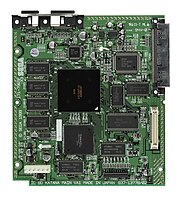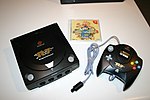Dreamcast
Dreamcast is the fifth and last home video game console produced by Sega. Belonging to the sixth generation of video game consoles, it is the direct successor of the Sega Saturn and competed with Sony's PlayStation 2. It was released on November 27, 1998 in Japan, on September 9, 1999 in North America, on October 14, 1999 in Europe, and on November 30, 1999 in Oceania.
Designed with a cost reduction policy, the hardware used a 32-bit CPU with a Hitachi SH-4 processor, a 128-bit NEC PowerVR2 graphics processor and GD-ROM reader, a special optical disc format. The console had an operating system based on Microsoft's Windows CE, and was the first on the market to have an integrated modem for browsing the Internet and playing online. The Visual Memory Unit memory card (VMU) incorporated an LCD screen and could be used as a portable mini-console in some games.
The life cycle of the Dreamcast was marked by Sega's financial crisis and the loss of market share it had experienced compared to PlayStation. After a discreet launch in the Japanese market, the company reduced the launch price to improve results in North America and Europe. The announcement of the PlayStation 2 in March 1999 led to stagnant sales and the loss of support from numerous third-party developers. After a change in management, Sega announced it would cease production of the Dreamcast as of March 31, 2001 and restructure itself to become an independent developer. In total, 9.13 million consoles were sold worldwide.
Despite its short useful life and the lack of third-party support, the specialized press considers that the Dreamcast was a video game console ahead of its time. Among its library of more than 600 games, innovative titles in the era such as Crazy Taxi, Jet Set Radio, Phantasy Star Online, Shenmue, Space Channel 5 and Sonic Adventure, as well as numerous arcade adaptations thanks to its architecture based on the Sega NAOMI board. Although Dreamcast production stopped in 2001, the system was supported until 2007.
Within the sixth generation, Dreamcast only coincided with PlayStation 2; The launches of Xbox and Nintendo GameCube in the second half of 2001 occurred when Sega had already stopped manufacturing video game consoles.
History
Background
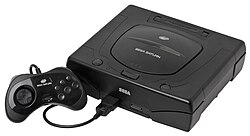
Dreamcast came onto the market in a complicated context for Sega. The Japanese company had struggled in the 1990s to lead the video game sector in competition with Nintendo, and experienced its golden stage in the fourth generation thanks to the commercial success of the Mega Drive, which had sold more than 30 million units. However, Sega's reputation was damaged by the commercial failure of the following consoles and peripherals that came to market, to the point of reducing its financial results. The successor to the Mega Drive, Sega Saturn, had been launched in 1994 as a fifth-generation CD-ROM video game console that could handle three-dimensional graphics, but its performance was hampered by a series of commercial errors and its complex dual-processor architecture, which made game programming difficult while increasing production costs. In this way, Saturn was surpassed in all markets by a new direct rival, Sony's PlayStation. In total 9 million Sega Saturns were sold in its lifetime; While in Japan it had been the second system in market share, with discrete figures although higher than those of the Mega Drive, in the Western market it was widely surpassed by PlayStation and Nintendo 64.
Rumors about the development of a new console were confirmed when Bernie Stolar, head of Sega of America, said publicly that Saturn "is no longer the future" of the company, hinting that the company was already working on another peripheral. After Sega declared losses in 1998 for the first time since its IPO, president Hayao Nakayama resigned and was replaced by Shōichirō Irimajiri, who ordered the production of the Sega Saturn to cease. to prepare for the launch of Dreamcast.
Development

Sega began working on a new video game console in late 1996, shortly after the launch of the Nintendo 64. Due to the high manufacturing cost of the Saturn, they wanted to reduce costs by using external components from PC games. The most common graphics processor standards at the time were Videologic's PowerVR and 3dfx's Voodoo chip, so Sega launched two separate development teams. On the one hand, the then head of Sega of America, Shōichirō Irimajiri hired engineer Tatsuo Yamamoto to work with Hitachi and 3dfx on the "Blackbelt" project that would be developed in the US. On the Japanese side, lead designer Hideki Sato promoted the "Dural" project from Japan, which used a Hitachi CPU and PowerVR GPU. In July 1997, the company opted for the Dural project for technical and budgetary reasons, although it added some Blackbelt elements for the final result. In early 1998, the Dural project was made public in the press under the code name "Katana".
Sega promoted software development kits based on computer games to facilitate the work of programmers, since many of them had given up programming for Saturn due to the complexity of that system. The company even said that any game developed for a Pentium II 200 could be compatible on the new game console. The Katana hardware had a 32-bit CPU with a Hitachi SH-4 processor plus a PowerVR2 128-bit graphic manufactured by NEC. The operating system of the game console was a modified version of Windows CE developed by Microsoft that was compatible with DirectX. Costs were also reduced in the physical format: Sega opted for its own format, the GD-ROM, which had a larger capacity than a CD and was cheaper to produce than DVD-ROM. Finally, the console integrated a 56kbp/s modem to be able to play online.
Sega chose the name of its video game console through a public contest among 5,000 proposals. The final choice, "Dreamcast", was a portmanteau of the English words dream (dream) and broadcast (transmission). One of its objectives was to create a new unrelated brand manufacturer; The developer's logo only appeared on the front of the case. In total, it invested more than 50 million dollars in hardware development, 150 million in software and more than 300 million in advertising campaigns. The company also had to face a lawsuit from 3dfx against Sega and NEC for alleged breach of contract and unfair competition.
Dreamcast launch

The Sega New Challenge conference, held on May 21, 1998 in Tokyo, was the setting where Sega officially presented the Dreamcast. In addition to displaying the technical characteristics of the console, it was confirmed that there would be a new platformer in the Sonic the Hedgehog series, titled Sonic Adventure. The managers were confident that its premiere, which inaugurated the sixth generation of video game consoles, would serve to recover market share and get ahead of its rivals.
Dreamcast went on sale in Japan on November 27, 1998, at a price of 29,000 yen (about $210), and available units were sold out on the first day. A shortage of PowerVR chips during production forced the company to stop reservations because they had less stock than expected. Another drawback was the lack of games: there were only four titles released, of which the best-selling was the arcade adaptation Virtua Fighter 3, while the long-awaited Sonic Adventure was delayed a month and finally came out at Christmas. Japan was also the first region to have its own internet service. Sega had planned to exceed one million sales by February 1999, but by that date only about 900,000 units had been sold.
The console had a better start in Western markets, where Saturn had barely enjoyed any impact. To avoid the mistakes of the surprise premiere of its predecessor, the American division announced that the Dreamcast would be released on September 9, 1999, with a careful advertising campaign that sought to generate expectation. Bernie Stolar redirected the relationship with the US department stores., promoted a larger output catalog with eighteen references, and managed to secure 300,000 reserved consoles thanks to an offer of $199 in search of the trust of players who had grown up with Mega Drive. This decision had not been agreed upon with the board. Sega's board of directors, who intended to impose a price of $249 to make it profitable, so Stolar was fired by the Japanese parent company a month before the launch, being replaced by vice president Peter Moore. Another inconvenience was the refusal of Electronic Arts - the biggest video game developer at the time—to publish games for the Dreamcast. As of September 9, the Dreamcast's U.S. debut was a success with 225,000 units sold on the first day and over a million in both. first months, which represented 30% of the market share. The biggest sales successes then were Sonic Adventure, the fighting game Soulcalibur and an American football simulator, NFL 2K, developed by Visual Concepts.
In Europe, the premiere arrived on October 14, 1999 at a price of 200 euros (in Spain, 39,900 pesetas), with a catalog similar to that of North America. The European online gaming service – Dreamarena – was launched on the same day of launch. The company claimed to have sold more than 400,000 Dreamcast consoles during the first month on that continent.
Competition in the sixth generation
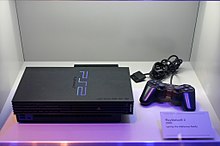
Although the launch of the Dreamcast was described as successful, PlayStation continued to lead the video game sector easily. Sega's video game console was eclipsed in March 1999 by the official announcement of the PlayStation 2, which among other specifications promised better graphical performance, DVD-ROM playback, exclusive franchises and backward compatibility with its predecessor. As time went by, Microsoft confirmed its debut in the sector with Xbox and Nintendo announced the development of GameCube.
By the end of 1999, more than 1.5 million Dreamcasts had been sold worldwide. Growth slowed at the beginning of the following year, coinciding with the release of the PlayStation 2 in March 2000. Low sales In Japan, the developers' commitment to PS2 and the costs of the launch in the West - where sales had indeed exceeded the company's expectations - caused Sega to record fiscal losses for the third consecutive year. Added to this was the rise of video game piracy: the GD-ROM format was intended to limit this practice, but in 2000 a security flaw was discovered that allowed pirated games and even emulators to be played with just a boot disk. All of this meant that Sega could not compensate the losses of hardware with sales of software.
Sega officials launched an aggressive advertising campaign to increase Dreamcast sales in North America, before the launch of the PS2 there in November. The US division launched its own internet service provider, SegaNet, in September 2000, at a price of 21.95 per month. At the same time, the console was discounted to $149 with a free keyboard. On the other hand, the Japanese division offered a $200 cash refund to any Dreamcast owner who made a two-year subscription to its streaming platform. internet. Although Sega of America estimated to sell five million Dreamcasts in North America by the end of 2000, their threshold to make it a viable platform, they fell far short of the goal with almost three million consoles distributed. In Europe the That figure had plateaued at one million sales by the end of 2000. In the end, the most successful system that year in the US was the PSOne – a redesign of the PlayStation – and most gamers waited for PS2 stock to rise., which swept the Christmas campaign. All of this caused Sega's losses to double and the company to enter an unsustainable financial situation.
Cessation of production
In May 2000, Shōichirō Irimajiri resigned as head of Sega and was replaced by Isao Okawa, from CSK. The new president had long argued that Sega should abandon the console business, an idea shared by other historical figures such as David Rosen, the co-founder of Sega, and former executive Bernie Stolar. At a meeting in September 2000, Peter Moore and Charles Bellfield—both from the North American division—recommended stopping manufacturing hardware to focus on game development if it wanted to survive. Faced with the proposal, the heads of the main developers left the meeting However, the speech served for the board of directors to assume the future in a scenario marked by greater competition, especially Microsoft's Xbox, where Sega could not compete as a manufacturer.
On January 31, 2001, Sega announced the cessation of production of the Dreamcast as of March 31, 2001 and the reconversion of the company into a third-party developer. To facilitate the transition process, Isao Okawa He carried out debt forgiveness and donated more than 85 billion yen ($695 million) to the company, including his shares in the company. Okawa died two months after the announcement, the victim of a heart attack. On the other hand On the other hand, Sega confirmed a liquidation of all Dreamcast stocks, estimated at 930,000 units, starting in April 2001. The restructuring also led to the dismissal of a third of the Japanese division's staff. The abandonment of the hardware served to avoid bankruptcy: after five years with financial losses, Sega once again recorded profits in the fiscal balance of 2003.
At the end of its useful life, 9.13 million Dreamcasts had been sold worldwide. After production ceased, nearly fifty official games were published until mid-2002, including titles such as Sonic Adventure 2 and Shenmue II. Sega maintained the online game servers until 2003 and technical support until 2007.
Hardware and accessories
Hardware
The Dreamcast's CPU is a 200 MHz 32-bit Hitachi SH-4 processor with 360 MIPS performance, an 8 kbs instruction cache, and a 16 kbs data cache. The GPU is a graphics processor. 128-bit NEC PowerVR2, integrated into the ASIC, which could render up to 3.5 million polygons per second and was capable of graphical effects such as deferred shading, Gouraud shading, spatial smoothing and Z-buffering among others. In addition, the GPU shares architecture with the NAOMI arcade board. The working memory consists of 16 MB of central RAM, 8 MB of VRAM and 2 MB of audio. And the audio processor, a Yamaha AICA with 32-bit RISC architecture, can generate 64 simultaneous audio channels. The video output allows a resolution of 640 x 480 pixels and can reproduce up to 16.77 million colors. In addition to the standard RCA connector, a VGA adapter can be used to connect to a computer or equipment with 480p resolution.
The console has a white casing and measures approximately 190 mm wide by 195 mm long and 78 mm high. Being more compact than its predecessor, the CPU was covered by a metal heatsink to improve cooling, somewhat which at the time was not common. At the top is the GD-ROM disk reader unit, while on the front there are four ports for control controls. The discs have a capacity of 1.2 GB, slightly larger than a CD. Finally, Dreamcast was one of the first game consoles to have an operating system, an adapted version of Windows CE in collaboration with Microsoft.
A feature of the Dreamcast is the use of external components from PC games to reduce costs, something that Sega took into account after the problems suffered with the Saturn's dual processor. The company provided software development kits, very similar to a computer tower, so that programmers could become familiar with its architecture. Unlike what happened with Saturn, Dreamcast was a console completely oriented to three-dimensional environments and had an arcade board that shared its architecture, the Sega NAOMI, which allowed faithful conversions of arcade games.
Technical specifications
GD-ROM
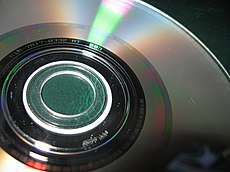
Dreamcast uses a unique optical disc format, GD-ROM, developed by Yamaha. It looks similar to a CD-ROM, but its slots are more compact and it can store more information, about 1.2 Gigabytes. In addition to being much cheaper to produce than a DVD, this format was intended to avoid the piracy of video games that had affected other systems such as PlayStation. The marketing of blank GD-R was limited to manufacturers. Dreamcast was the only video game console of the sixth generation that used a format based on CD technology, since even the GameCube minidisk could store twice as much information as it was based on DVD technology.
Over time, the GD-ROM proved ineffective in stopping piracy. Developers discovered in 2000 that one of the supports programmed for the Dreamcast, the MIL-CD—a music disc with interactive features—carried a security hole that allowed the console to load any pirated game from a standard CD-R with proper compression. MIL-CD support was removed on systems manufactured after November 2000.
Accessories
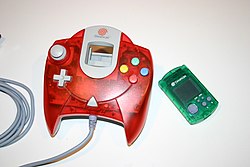
Dreamcast had numerous accessories throughout its useful life. The wired controller included in the console includes an analog stick, a directional pad, four face buttons, a start button and two analog triggers. At the top there are two expansion slots: the front one allows you to insert the memory card, while the rear one is used for other accessories such as vibration. The official controller was highly criticized for its design; Edge claimed that it was "an ugly evolution of the Sega Saturn's 3D Control Pad", and other publications such as IGN or Hobby Consolas have described it as a peripheral that is quite uncomfortable to use. Other official products were also marketed such as an arcade controller, a microphone, a keyboard and mouse, steering wheels for racing games, an optical gun, a dance mat and even a fishing rod.
The Dreamcast memory card is called Visual Memory Unit (VMU) and is a 128 KB storage device with a built-in LCD screen, audio output, and a four-button directional pad. The VMU screen displays game information, allowing it to also be used as a portable game console or even as an external screen. Dreamcast was the first and only Sega game console that used external storage, since in previous systems such as the Sega Saturn or Sega CD had opted for internal memory.
In September 2000, Dreameye went on sale, a digital camera that allows the player to interact with what appears on the screen, exchange photos and make video calls over the Internet. This peripheral could be purchased separately or together with the Visual Park video game, but it never left Japan. Three years later, Sony manufactured its own digital camera for PS2, the EyeToy.
Internet connection
Dreamcast was the first video game console on the market with an integrated modem for browsing the internet and playing online. Sega had already tested internet connectivity on the Sega Saturn through an external peripheral, the Sega Net Link, and a modular modem was included as standard on the Dreamcast. A modem with 33.6 kbit/s transfer speed was used in the first Japanese model and in all PAL consoles. The NTSC consoles and the Japanese model after September 9, 1999 incorporated a 56 kbit/s modem. s. At first the modems were for dial-up connection, but starting in 2000 a broadband accessory was marketed in Japan and the US. Instead of having a unified global service, each market had its own own platform.
In Japan the internet service was called "Dricas" and was launched on October 28, 1998, just in time for the launch of the console. Most of the infrastructure was developed by ISAO Corporation, which spun off from Sega on November 26, 1999. The Internet browser, Dream Passport, allowed you to connect to the Internet via dial-up, browse websites, receive and send email, and chat with other users. On March 7, 2000, Dricas was replaced by ISAO's own service, "isao.net", and remained until 2007.
In Europe, the "Dreamarena" platform began operating on October 14, 1999 and was operated by Sega Europe in collaboration with ICL, BT and national providers - in Spain, Telefónica -, with variable conditions depending on the country. The service was accessible through the DreamKey browser, distributed with the console and with certain games such as ChuChu Rocket!. Version 3.0 of DreamKey allowed users to access the Internet through the provider of their choice. Dreamarena remained open until February 28, 2003.
Internet service in the United States took longer to become available, on September 7, 2000. The "SegaNet" platform was developed in collaboration with providers such as GTE and AT&T. The service required a monthly subscription for $21.95, but there were offers if longer-term rates were contracted. Sega of America already had experience in this field thanks to a previous online gaming platform for computers, and SegaNet was well received thanks to games like NFL 2K1. The Internet connection was made through the PlanetWeb browser. The online service was only available on the mainland and remained open until 2003.
In October 2000 there were 1.4 million Dreamcasts registered online: 750,000 in Japan, 400,000 in North America, and 400,000 in Europe. This figure is very high for the era if you take into account that Xbox Live, the worldwide Xbox service launched in 2002, took two years to reach one million users. The video game Phantasy Star Online kept the servers open until December 31 March 2007.
Models
Sega produced several Dreamcast models, many of which were exclusive to Japan. The common white casing design is identical between regions except for details such as the color of the logo (orange in Japan and North America, blue in Europe and Oceania), the material used in the plastic triangle that covers the power light, and compatibility of formats. The Japanese model incorporates the text "Designed for Microsoft Windows CE" on the front, while in North America and Europe it appears "Compatible with Microsoft Windows CE"
Among the exclusive models from Japan, the Divers 2000 CX-1 stands out, a hybrid of console and television in the shape of Sonic's head, and which also incorporated a microphone and the Dreameye for video conferencing. The Dreamcast R7, characterized by its black casing, was a model used in pachinko parlors. That market also had customized casings for games such as Resident Evil - Code: Veronica, Sakura Taisen, Seaman and Sonic Adventure, to which we must add a special edition of Hello Kitty. In North America a Limited edition of Sega Sports with black casing, a controller of the same color and two games.
Software
Video games
Dreamcast has more than 600 official games, mostly developed by Sega itself through semi-autonomous studios. The copies for sale to the public were distributed in a GD-ROM with a plastic case and its corresponding manual. Games are region locked: software purchased in a region can only be played on hardware in that same region. After production ceased in March 2001, official games continued to be published until mid-2002 in the United States. The last licensed title, Karous, was released in Japan in 2007.
The best-selling Dreamcast video games were Sonic Adventure (2.42 million copies), Crazy Taxi (1.81 million), NFL 2K (1.20 million), Shenmue (1.18 million) and Resident Evil - Code: Veronica (1.1 million).
Main developers
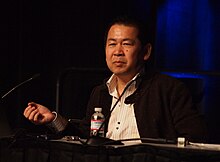
In what has been defined as "a brief moment of remarkable creativity," Sega restructured its video game departments into nine semi-autonomous studios in 2000 under the direction of its best programmers. The main developers that Sega had were United Game Artists (UGA), Hitmaker, Smilebit, Overworks, WOW Entertainment, Amusement Vision, Sega Rosso, Wave Master and Sonic Team. As for Sega-AM2, it remained under the control of CSK. and became an autonomous studio in 2001. Sega gave developers the opportunity to experiment freely, which resulted in a wide catalog of innovative games for the time. Although the Dreamcast had a short life cycle, many of Those titles were so popular that they have been reissued on other systems.
Yū Suzuki produced with the AM2 studio one of the most representative Dreamcast series, Shenmue (1999) and Shenmue II (2001). It is an open world video game where Ryo Hazuki, a martial artist, travels to different locations to avenge the murder of his father. Presented in a four GD-ROM format, Shenmue stood out for its high level of graphic detail and for the innovations it introduced, such as an environment subject to changes in weather and time, secondary characters with daily routines, and numerous interactive elements. The first title in the series had excellent reviews and managed to sell about 1.2 million copies, but it was not enough to cover the high production budget. Some time later it has been described as a cult work for its contribution to the industry.
Sonic Adventure by Sonic Team, the first three-dimensional platform starring Sega's mascot, was the key piece in the launch of the Dreamcast in the Western market and became its best-selling game with 2, 5 million units distributed. It had a second part, Sonic Adventure 2, which came onto the market when they had already stopped manufacturing the console. Yūji Naka's studio also developed ChuChu Rocket!, one of the first online games for video consoles; the musical Samba de Amigo, which used a maraca-shaped peripheral, and the role-playing game Phantasy Star Online, one of the first massively multiplayer online video games for console.

UGA, Tetsuya Mizuguchi's studio, handled both the arcade conversions of Sega Rally and two groundbreaking titles: Space Channel 5 and REZ . Space Channel 5 was a musical game aimed at female audiences where Ulala, a space reporter, had to fight aliens with the power of dance. For its part, REZ It combined matamartianos with electronic music and came out months after the Dreamcast said goodbye. Hitmaker made two notable arcade conversions: Crazy Taxi, an open-world driving game, and the sports simulator Virtua Tennis. Overworks published the third installment of Sakura Taisen and the new Skies of Arcadia, a role-playing game designed by Rieko Kodama, which achieved good reviews for its universe inspired by the work of Jules Verne. And Smilebit was in charge of Jet Set Radio, an example of Sega's creative stage in the 2000s. The action title is set in Tokyo and its protagonists are a band of rebellious skaters who paint graffiti, flee from the authorities and fight against rival gangs. Jet Set Radio enjoyed good reviews thanks to its soundtrack, its gameplay and the popularization of cel shading graphics.
Creative freedom also led to the publication of exclusive experimental titles. One of the most successful was Seaman, a virtual pet created by Yutaka Saito, where the player had to take care of a fish with a human face and could talk to it through a microphone. Seaman i> was so popular in Japan that it became the second best-selling Dreamcast title in that market, only surpassed by Resident Evil - Code: Veronica. Also notable was The Typing of the Dead, a version of The House of the Dead 2 in which you had to kill zombies by typing on a keyboard; L.O.L: Lack of Love, a evolutionary simulator with a soundtrack by Ryūichi Sakamoto, and Segagaga, a role-playing video game exclusive to Japan where the player had to save Sega itself from bankruptcy.
Sega developed a line of sports video games, through the American studio Visual Concepts, with licenses from the major American leagues: NBA 2K (basketball), NFL 2K (American football) and NHL 2K—ice hockey. These titles were the response to EA Sports' refusal to publish for the Dreamcast, and stood out both for their graphic novelties and for the use of online play. After Sega sold Visual Concepts for $24 million in 2005, the NBA 2K series has continued under the leadership of Take-Two Interactive and has become the best-selling basketball simulator. Dreamcast never had a soccer simulator that enjoyed the same popularity as FIFA and Pro Evolution Soccer. At the European level, Sega founded a French subsidiary, No Cliché, and collaborated with the British studio Bizarre Creations (Metropolis Street Racer) and the Swedish studio Amuze (Headhunter) among others.
External developers
Before the launch of the Dreamcast in Japan, Sega introduced the NAOMI arcade motherboard. The successor to the Sega Model 3 was a cheaper alternative due to its mass production. NAOMI shared the same system structure as the Dreamcast, allowing conversions almost identical to those of an arcade machine. In addition to Sega, many companies took advantage of this feature to port their games. The Dreamcast also used PC components that could be found in Pentium II and Pentium III processors, which made it easier to convert games. like Quake III Arena.
Dreamcast had little support from third-party developers due to its low sales, the greater profitability of PlayStation, and distrust following the failure of the Sega Saturn. This was the main reason why Electronic Arts and its subsidiary EA Sports, the most important developers at the time, refused to publish for them from the beginning. There were numerous independent companies that published games, including Acclaim, Capcom, Eidos, Konami, Infogrames, Midway, Namco, Neversoft, Sammy, SNK, Tecmo, Treasure and Ubisoft. However, many of those companies—especially Namco and Konami—reserved their most ambitious projects for PS2.
One of the Dreamcast titles with the most impact was Soulcalibur, developed by Namco exclusively for the Dreamcast. Soulcalibur was a sword fighting video game developed on the Namco System 12 arcade board, and the studio knew how to take advantage of the technical characteristics to make a port faithful to the original arcade that served of reference to other external companies. On the part of Capcom, it is worth highlighting the publication of exclusives such as Resident Evil - Code: Veronica, Project Justice: Rival Schools 2, Tech Romancer and the Power Stone series.
Homebrew and emulation
Dreamcast had a modest community of homebrew developers. The Windows CE development kit options, as well as the versions of the Linux and NetBSD operating systems for this console, gave programmers a selection of development tools with which they could work. After production ceased, there were independent studios that published their own games, including NG. Dev. Team (Last Hope, Gunlord).
The security breach of the MIL-CD, which allowed pirated games to be loaded from a simple standard CD-R, led to the development of numerous emulators. The best known of all was Bleemcast!, a loading CD-R that allowed you to play PlayStation video games on the Sega console. The Bleemcast! CDs They corresponded to individual titles, so you had to load a specific disc into the Dreamcast and then replace it with the original PlayStation game that corresponded with that disc. Although it was not official software nor was it endorsed by Sony or Sega, at that time Bleem! It benefited from a loophole regarding emulators that allowed it to become a commercial product.
In addition, the homebrew community has developed emulators for other video game consoles and arcades, conversions of PC games, video players for different formats, and conversions of other operating systems.
Sales

Globally, with a total of 9.13 million units sold, Dreamcast occupied the last position of the sixth generation of video game consoles, according to data collected by VG Chartz. PlayStation 2 became the best-selling console of history with 158 million units, while Xbox (24.65 million) and GameCube (21.74 million) had a more discreet performance but also surpassed their rival.
Although the Dreamcast sold quantitatively less than the 9.26 million Sega Saturn, it had a greater commercial performance because it equaled its figures in less time. The market where it was best received was North America with more than 3.9 million units thanks to the different promotional campaigns, followed by Europe (1.91 million) and the rest of the world (1.07 million). On the contrary, in Japan it barely exceeded 2.25 million units, compared to the 5.75 million Saturn sold in that country.
Advertising
The name Dreamcast is a portmanteau of the English words dream (dream) and broadcast (transmission). At the time Sega did not want to associate its name with the console to generate a new brand, similar to what Sony had achieved with PlayStation. The logo was an orange spiral; In Europe they had to change the color to navy blue because the original design was similar to that of the German developer Tivola Games.
Sega opted in Japan for a humorous advertising campaign starring Hidekazu Yukawa, the company's managing director. Yukawa portrayed himself in the ads as a manager depressed by the decline of Sega, but who regains his spirits thanks to the launch of the Dreamcast. The comic profile of the campaign was reinforced with the arrival of the idol. i> Hideaki Takizawa, who helps him fall better to regain the public's trust. The advertising was so popular that Yukawa appeared on Dreamcast boxes and even had its own video game in 1999, Yukawa Motosenmu no Otakara Sagashi.
In the Western market, Sega focused its advertising on both adult audiences and experienced gamers. In the United States, the FCB studio based the It's thinking campaign on generating excitement, first with the release date and then with the catalog of available games. In Europe, online gaming connectivity was valued under the slogan Up to 6 billion players. In addition, Sega signed sponsorship agreements with four football clubs: Arsenal F. C. (England), Deportivo de la Coruña (Spain), A. S. Saint-Étienne (France) and U. C. Sampdoria (Italy).
Legacy
At the time of its launch, Dreamcast had good reviews from the press, which highlighted aspects such as the 128-bit graphics and the new online functions. In December 1999, Next Generation magazine described the Dreamcast as "a powerful system capable of displaying good graphics at a reasonable price", but at the same time warned that Sony and Nintendo were preparing releases with greater technical potential Edge magazine shared that forecast that same month and stated that, if it wanted to survive, Sega had to "ensure the support of external developers and release more triple-A games" to regain market share from its competitors. rivals.
Among the reasons that explain its premature end, the press has highlighted the players' disdain for Sega in favor of Sony and the new PlayStation 2; the lack of support from external developers—especially Electronic Arts and Squaresoft—; Sega's financial crisis, and Isao Okawa's disinterest in the desktop video game console business. Another reason cited was that the market was not ready at that time for online gaming, as connectivity had not been developed enough. In GamePro, analyst Blake Snow wrote that the Dreamcast was "a console ahead of the competition, but at the same time dealing with the negative image [of Sega] due to the mistakes made with the Sega Saturn, Sega 32X and Sega CD." /i>». Consequently, "casual gamers and already chastened developers doubted Sega's ability to keep its word."
Subsequently, the Dreamcast has been defined by the specialized press as a console ahead of its time. Sega's latest system introduced innovations such as the integrated modem to connect to the Internet and the first massive online gaming and MMORPG services. on a desktop video game console. The VMU allowed you to continue games without having to be connected to the console, as well as unlock mini-games, and there were other peripherals such as the Dreameye digital camera or the microphone to interact with compatible game characters. For Lastly, Sega was a pioneer in using motion detection in its special fishing rod-shaped controller, initially designed for Sega Bass Fishing but which was also compatible with other games such as Soulcalibur i> and Virtua Tennis.
Contenido relacionado
The Legend of Zelda: Twilight Princess
Spectravideo SVI-318
Super Mario Bros.
PlayStation (console)
Street Fighter II': Hyper Fighting

